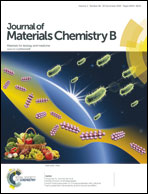Evaluation of borate bioactive glass scaffolds as a controlled delivery system for copper ions in stimulating osteogenesis and angiogenesis in bone healing
Abstract
Biocompatible synthetic scaffolds with enhanced osteogenic and angiogenic capacity are of great interest for the repair of large (critical size) bone defects. In this study, we investigated an approach based on the controlled delivery of copper (Cu) ions from borate bioactive glass scaffolds for stimulating angiogenesis and osteogenesis in a rodent calvarial defect model. Borate glass scaffolds (pore size = 200–400 μm) doped with varying amounts of Cu (0–3.0 wt% CuO) were created using a polymer foam replication technique. When immersed in simulated body fluid (SBF) in vitro, the scaffolds released Cu ions into the medium at a rate that was dependent on the amount of Cu in the glass and simultaneously converted to hydroxyapatite (HA). At the concentrations used, the Cu in the glass was not cytotoxic to human bone marrow derived stem cells (hBMSCs) cultured on the scaffolds and the alkaline phosphatase activity of the hBMSCs increased with increasing Cu in the glass. When implanted in rat calvarial defects for 8 weeks, the scaffolds doped with 3 wt% CuO showed a significantly better capacity to stimulate angiogenesis and regenerate bone when compared to the undoped glass scaffolds. Together, these results indicate that the controlled delivery of Cu ions from borate bioactive glass implants is a promising approach in healing bone defects.


 Please wait while we load your content...
Please wait while we load your content...